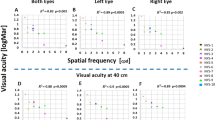Abstract
• Background: Early childhood nystagmus may herald blindness, brain tumors, benign idiopathic motor nystagmus or spasmus nutans. Nystagmus unique to low vision was sought.
• Methods: Videotapes and head/eye movements of 18 congenitally visually impaired subjects were analyzed.
• Results: Nystagmus of congenitally visually impaired subjects was characterized as small horizontal or vertical movements superimposed on larger oscillations. Small and large nystagmus movements were of pendular or jerk type. Slow-phase jerk nystagmus had increasing, constant and decreasing velocities. Fast-phase nystagmus changed direction periodically. Pendular nystagmus was out of phase and evolved to jerk nystagmus in two subjects. All subjects displayed head nodding, and one stabilized gaze with head movements.
• Conclusion: Eye movement recordings allow characterization and differentiation of subjects with nystagmus and low vision from other nystagmus forms.
Similar content being viewed by others
References
Abadi RV, Dickinson CM (1986) Waveform characteristics in congenital nystagmus. Doc Ophthalmol 64:153–167
Carl JR, Optican LM, Chu FC, Zee DS (1985) Head shaking and vestibulo-ocular reflex in congenital nystagmus. Invest Ophthalmol Vis Sci 26:1043–1050
Dell'Osso LF (1985) Congenital, latent and manifest latent nystagmus —similarities, differences and relation to strabismus. Jpn J Ophthalmol 29:351–368
Gottlob I, Reinecke RD (1994) Eye and head movements in patients with achromatopsia. Graefe's Arch Clin Exp Ophthalmol 232:392–401
Gottlob I, Fendick M, Guo S, Zubcov AA, Odom JV, Reinecke RD (1990) Visual acuity measurements by spatial swept visual-evoked-cortical-potentials (VECPs): clinical application and reliability in children with various visual pathway disorders. J Pediatr Ophthalmol Strabismus 27:40–47
Gottlob I, Zubcov A, Catalano RA, Reinecke RD, Koller HP, Calhoun JH, Manley DR (1990) Signs distinguishing spasmus nutans (with and without central nervous system lesions) from infantile nystagmus. Ophthalmology 97:1166–1175
Gottlob I, Zubcov AA, Wizov SS, Reinecke RD (1992) Head nodding is compensatory in spasmus nutans. Ophthalmology 99: 1024–1031
Gresty MA, Halmagyi GM (1979) Abnormal head movements. J Neurol Neurosurg Psychiatry 42:705–714
Gresty M, Leech J, Sanders M, Eggars H (1976) A study of head and eye movement in spasmus nutans. Br J Ophthalmol 60:652–654
Jan JE, Groenveld M, Connolly MB (1990) Head shaking by visually impaired children: a voluntary neurovisual adaptation which can be confused with spasmus nutans. Dev Med Child Neurol 32:1061–1066
Koenig SB, Naidich TP, Zaparackas Z (1982) Optic glioma masquerading as spasmus nutans. J Pediatr Ophthalmol Strabismus 19:20–24
Lambert SR, Newman NJ (1993) Retinal disease masquerading as spasmus nutans. Neurology 43: 1607–1609
Lavery MA, O'Neill JF, Chu FC, Martyn LJ (1984) Acquired nystagmus in early childhood: a presenting sign of intracranial tumor. Ophthalmology 91:425–435
Leech J, Gresty M, Hess K, Rudge P (1977) Gaze failure, drifting eye movements, and centripetal nystagmus in cerebellar disease. Br J Ophthalmol 61:774–781
Leigh RJ, Zee DS (1980) Eye movements of the blind. Invest Ophthalmol Vis Sci 19:328–331
Leigh RJ, Thurston SE, Tomsak RL, Grossman GE, Lanska DJ (1989) Effect of monocular visual loss upon stability of gaze. Invest Ophthalmol Vis Sci 30:288–292
Metz HS, Jampolsky A, O'Meara DM (1972) Congenital ocular nystagmus and nystagmoid head movements. Am J Ophthalmol 74:1131–1133
Ohm J (1950) Der Nystagmus bei Blinden. Graefe's Arch Clin Exp Ophthalmol 151: 293–326
Pritchard C, Flynn JT, Smith JL (1988) Wave form characteristics of vertical oscillations in longstanding vision loss. J Pediatr Ophthalmol Strabismus 25:233–236
Reinecke RD, Guo S, Goldstein HP (1988) Waveform evolution in infantile nystagmus: an electro-oculo-graphic study of 35 cases. Binocular Vis 3: 191–202
Robinson DA (1963) A method for measuring eye movement using a scleral search coil in a magnetic field. IEEE Trans Biomed Electronics 10:137–145
Robinson DA (1974) The effect of cerebellectomy on the cat's vestibuloocular integrator. Brain Res 71: 195–207
Weissman BM, Dell'Osso LF, Abel LA, Leigh RJ (1987) Spasmus nutans: a quantitative prospective study. Arch Ophthalmol 105:525–528
Yee RD, Baloh RW, Honrubia V (1981) Eye movement abnormalities in rod monochromacy. Ophthalmology 88:1010–1018
Yee RD, Farley MK, Bateman JB, Martin DA (1985) Eye movement abnormalities in rod monochromatism and blue-cone monochromatism. Graefe's Arch Clin Exp Ophthalmol 223:55–59
Author information
Authors and Affiliations
Rights and permissions
About this article
Cite this article
Gottlob, I., Wizov, S.S. & Reinecke, R.D. Head and eye movements in children with low vision. Graefe's Arch Clin Exp Ophthalmol 234, 369–377 (1996). https://doi.org/10.1007/BF00190713
Received:
Revised:
Accepted:
Issue Date:
DOI: https://doi.org/10.1007/BF00190713




